History of Massage, Culture, Sex, Repression and Civilisation
by James Khan
Ancient Cultures, Sex and Judeo-Christian Guilt
Ancient Chinese and Japanese Massage
Babylonian, Egyption and Arabic Massage
The Romans: Baths, Massage and Pleasure
Christianity, the Fall of Rome and The Death of Massage
The Messiah: Constantine the Great
Sin, Sexual Repression and Christianity
The Dark Ages: An Evil Unsurpassed in Human History
The British Empire and Global Sexual Repression
The Whabi House of Saud and Islamic Fundamentalism
The Psychological Effects of Sexual Repression
The Clinical or Robotic Rebirth of Modern Massage
Sex, Respectability and Clinical Massage Training
Modalities or Types of Massage Therapies
Non-Clinical Massage Therapies
Massage Parlors, Prostitution and Massage Training
Prospects for The Future of Massage
The Future is Bright, the Future is Clinical
Chronological History of Massage
Shamanistic Origins of Massage, Medicine and Healing

shaman
The Shaman, Witch Doctor or Sorcerer was the first Physician.
The Shaman’s Magic was complex and included the use of spells, mantras, incantations, massage, plants, herbs, mineral and animal substances.
The Ancients believed that disease (Dis-Ease) originated in the non-physical realms, which then manifested in the physical. They believed that this could be caused by the wrong acts, thoughts or attitudes of the person, or it could be the play demons or spirits (good or bad). Massage was used as a means of removing the demons, harmful spirits or other impurity from the body. Massage was used along with a prescription of cleansing herbs and plant extracts (which often would induce purging in the body. This was done in a ritual with smoke, drums, mantras and incantations that would possibly help to cleanse the mind of the patient from the mind set that led to his illness.
How the Shaman came to such detailed knowledge is unknown.
My view, which I have explored in detail in Ayahuasca Shamanic Journey: A Life UnVeiled is that animal man was led to this knowledge by hallucinogenic substances in plants.
This is what the Shaman will tell you is the origin of his knowledge and tradition. The Shaman were the first to use the ritual consumption of hallucinogenic plants as an aid to knowledge and healing.
Shamanic traditions and massage forms still exist in Africa, Australia (amongst the Aborigines), Central America, South America, North America, the Pacific Islands (esp Hawaii), the Philippines, Russia and the Ukraine.
For example, a popular Hawaiian massage form is Lomi Lomi which was an integral part of native healing arts that passed from generation to generation for centuries amongst native Shaman (the Kahuna). Lomi-Lomi was loved by Kings and Queens, who would used it as an aid to digestion and love making.. Captain Cook was offered Lomi-Lomi by a local native Chief; he reported being massaged by 12 women, who relived him of all his pains.
Similar native massage forms exist today in places like New Guinea, the Fiji Islands, the Tonga and Bali.
There are many examples from the old world of their having knowledge of how massage could be used for specific effects. For example, the technique of massage abortion, involving the application of pressure to the pregnant womens abdomen, has been practiced in Southeast Asia for centuries. One of the figures decorating the temple of Angkor Wat in Cambodia, dated circa 1150, depicts a demon performing such an abortion upon a woman who has been sent to the underworld.
Ancient Chinese and Japanese Massage
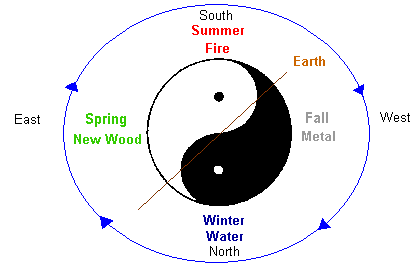
The most common modern massage form (Swedish massage), has its origin in Chinese massage. Henrik Ling, a gymnast, studied massage in China and brought back to the west the massage strokes that are used today in almost all massage forms.
These strokes include gliding strokes, kneading movements, circular pressures, oscillatory movements, hacking, tapping and bending and stretching.
Ling’s contribution to the development, use and popularity of modern clinical massage is huge. However, as Ling focused only on the strokes, the philosophy behind Chinese massage is missing and the resultant modern massage is sadly very clinical.
The ancient Chinese called their technique ‘amma’ (push-pull), which was particularly concerned with the movement of Life Energy (Ki, Qi or Chee) in the body using the therapists hands rather then acupuncture needles. The Chinese studied the flows of Yin and Yang energies (masculine and feminine) through the bodies energy pathways, and observed how these life energies connected with and nourished the organs, the bodily fluids like blood, lymph, and hormones. They developed a comprehensive system of massage that covered the physical, muscular, emotional and spiritual aspects of being that connected Male and Female with nature, the cosmos and with the Tao, the active divinity behind all observed phenomena.
Amma as a healing system dates back some 5,000 to the period of the Yellow Emperor and even prior periods. In the 27th century BC Chinese book called Huangdi Neijing by the Yellow Emperor recommended massage of skin and flesh as does his Classic of Internal Medicine.
Amma attains the harmony and flow of the five essential substances:
-
Qi (energy)
-
Jing (essence)
-
Shen (spirit)
-
Xue (blood)
-
Jin-ye (body fluids)
Amma techniques encompass pressing, stroking, stretching and percussive manipulations with thumbs, fingers, arms, elbows, knees, and feet on acupressure points along the body’s 14 meridians, or energy channels.
Amma stimulates the nervous and circulatory systems; maintains the muscles and organs in their best state of relaxation, flexibility and nutrition; keeps the blood supply flowing and helps to increase concentration by alleviating stress and releasing tension.
The Japanese also use the amma with similar pressure points called tsubo. Shiatsu is a direct descendant of this ancient massage practice.
Indian and Thai Massage
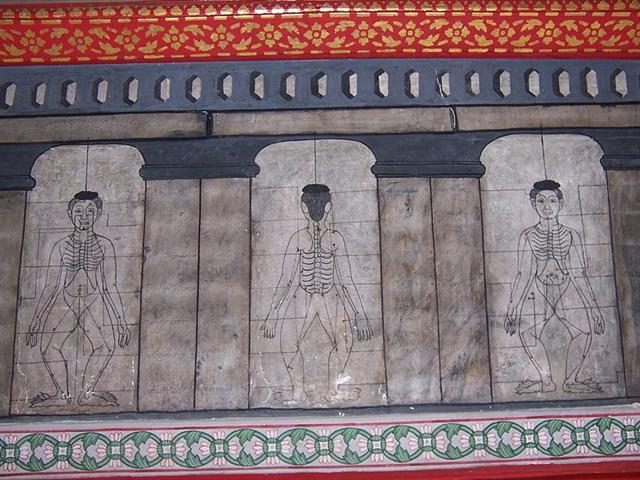
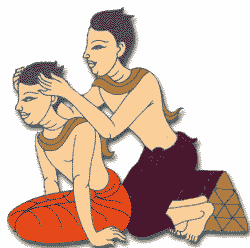
thai massage
In India massage has been used as part of Ayurvedic medicine since time immemorial. Massage therapies based on the ancient art are very common in India today, particularly in Southern India.
Thai Massage is very similar to Amma/Shiatsu, and is some 2,500 years old.
Thai massage though has its origins in India and is derived from Ayurveda, Yoga and Tantra.
This suggests that Indian and Chinese ancient cultures were well connected, with a free flow of information between them. Thai massage is the first massage that can be considered a synergy of ancient Indian and Chinese massage forms.
Doctor Bhaccha the Father of Thai Massage
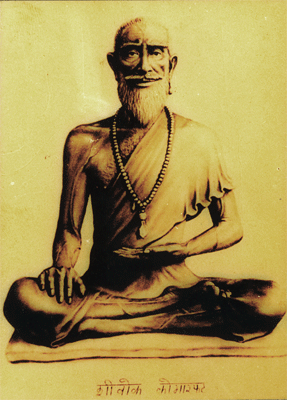
Thai massage is said to have been founded by Doctor Jivaka Kumar Bhaccha, who was from northern India and a contemporary of the Buddha and personal physician to the Magadha King Bimbisara.
Bhaccha’s work consisted of manipulative techniques as well as instruction in proper diet, herbs and other secret or occult practices. Before a practitioner performs this healing work, he/she first recites a mantra to this enlightened soul in Pali, the ancient sacred language of Theravada Buddhism, the language in which the Buddha taught.
This is translated as:
We invite the spirit of our founder, the Father Doctor Jivaka, who comes to us through his saintly life.
Please bring to us the knowledge of all nature, that this prayer will show us the true medicine of the universe.
In the name of this mantra, we respect your help and pray that through our bodies you will bring wholeness and health to the body of our client.
The goddess of healing dwells in the heavens high, while man kind stays in the world below.
In the name of the founder, may the heavens be reflected in the earth below so that this healing medicine may encircle the world.
We pray for the one whom we touch, that he/she will be happy and that any illness will be released from him/her.
This mantra shows how massage is connected to religious traditions, and highly respected amongst the general public in Thailand today as it was in older times.
Babylonian, Egyptian and Arabic Massage
Massage was use by the Babylonians, which in modified forms became the massage extensively used in the Arabic world. The Arabs (Babylonians, Egyptians) can be thought of as the founders of modern massage – the word ‘Massage’ is derived from the Arabic ‘Massa’.
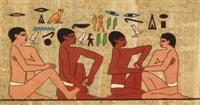
The ancient Egyptians regularly used massage and aromatic oils, made famous by such rulers as Cleopatra.
Initially, the Egyptian priests used the oils only for religious ceremonies and embalming rites.
However, at around 3000BC, they realized the advantages of using these essential oils for the living. Thus, they became healers, using these ‘magical’ oils and selling them as ‘magic’ potions.
Greek and Roman Massage
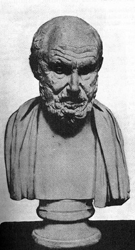
The Greeks and Roman societies used massage for health and for pleasure. Hippocrates, the father of Medicine, wrote in 460 BC that:
‘The physician must be experienced in many things, but assuredly in rubbing’
Herodotus, the teacher of Hippocrates, also wrote about the benefits of massage. Both Herodotus and Hippocrates believed that all doctors needed to know massage for healing.
The Romans: Baths, Massage and Pleasure
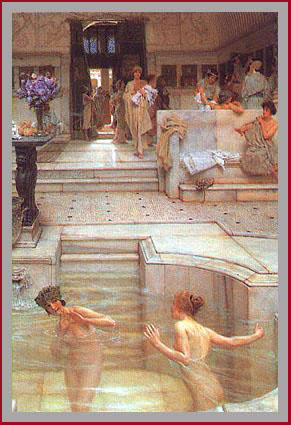
The Greeks first built Public Baths; but it was the Romans who made the bathhouse the center of their social lives. In the early days of the Roman Republic, wealthy citizens often installed private baths in their homes, similar to the modern Turkish bath.
The Romans were great believers in the effectiveness of massage, and massage was central to rituals at the Roman baths – which were used used for everyday social and business life.
At Turkish baths today, which are equivalent in some ways to the Roman baths, massage is still very important – but the mixed nude bathing and massages of the Roman times are, alas, a thing of the past.
Apart from the sensual pleasures from massage, the Romans also used massage for stiff and sore muscles, curing disease, strengthening the constitution and improving circulation.
The Greek/Roman physician Galen wrote many medical books stressing the use of massage for health.
Roman emperors were known to be particularly fond of their daily massages, some like Julius Caesar had a massage every day.
Roman Public Bath were in vogue in almost all cities and towns of the Empire.
Huge baths, or thermae, became the recreation centers of the Imperial City itself, providing not only bathing facilities but gyms, libraries, theaters, gardens, and assembly halls.
The Roman Baths were masterpieces of architecture and engineering, and the epitome of imperial luxury. The walls were usually covered with marble; the high, vaulted ceilings were decorated with colorful mosaics. The water taps were made of silver. Statues were everywhere, with small cubical lockers set in the niches between them. Hot water was provided by furnaces and piped into the bath. The rooms were kept warm by smoke and hot air circulating under the floors and in the hollow walls.
The first large Roman Public Bath was built by Agrippa in 27 B.C. Others were constructed by Nero (65 A.D.), Titus (81 A.D), Domitian (95 A.D.), Trajan (100 A.D.), Commodus (185 A.D.). Diocletian built baths in the year 302 that were large enough to accommodate 3,200 bathers at one time!
The Baths of Caracalla, constructed in 217, could accommodate 1,600 bathers in an area of more than a million square feet-an area which included a stadium. Extensive remains of many Roman baths still stand today.
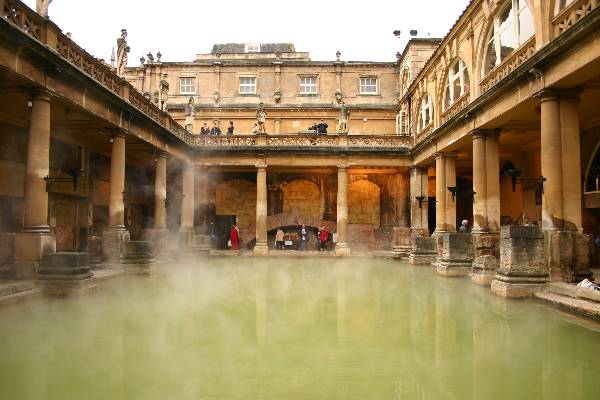
The Roman’s bathing ritual consisted of a series of baths, each taken in a different room. The bather began in the undressing room, then moved to another room where he was anointed with oil, and massaged. Then to the gym for exercise. After the gym came the calidarium, or hot bath; then the steam room, the tepidarium, or lukewarm bath; and finally, the frigidarium, or cold bath which was usually a sort of swimming pool.
Our modern health spa’s seem to be following on from the same Roman traditions!
For several hundred years, men and women bathed together in Rome. The Roman Baths were the social and entertainment centers of the time, combining the modern bar-room, health spa, community center and meeting places.
This is something that is very rare even in our ‘enlightened’ modern times. Public baths in the UK and US insist that swimming costumes be worn, or they will have single sex days where bathing costumes need not be worn.
.The attitude in much of Europe (in particular Germany, Scandinavia) though is different – mixed nude bathing is considered natural there, but it is still a long way from the glories of Rome.
Christianity, the Fall of Rome and The Death of Massage
After the fall of the Roman empire in the 5th century, the Greek and Roman passions for aromatics, baths and massage was purged and almost disappeared in Europe. The damage had started earlier when Constantine (274-337 CE) became the first Christian Roman Emperor, who transformed Christianity from squabbling groups into a coherent religion and installed it into power at his right hand. .
In the year 323 CE. Constantine’s army attacked and defeated his co-emperor, Licinius, to become Emperor of the whole Roman Empire.
Constantine the Great: The Christian Messiah
In Constantine’s time Christian tradition had not yet become immutable dogma, and Christianity was followed by a small number of people. This changed with the conversion of the Roman Emperor Constantine ‘The Great’ to Christianity.
As Emperor, Constantine became the Christians new Messiah – he had succeeded where Jesus had failed.
A Messiah was a military and political figure – a king with a mandate to govern. He summoned the Council of Nicaea in 325. The result was a unified and rationalized Christianity – but to suit his own ideas and psychotic needs.
Catholicism derives ultimately from this Council of Nicaea. Bishops became a branch of the Imperial civil service.
‘Constantine the Great’ as he is still known in Christianity, was a man who boiled alive his own Christian wife, and strangled to death his own relatives.
His favourite way of killing those who opposed him was to hang them up inverted, cut their throat and watch them die. He liked this because they would take a long time to die as blood remained in the head.
With Constantine, Jesus’s message of Love and Peace towards all was replaced by something very sinister. This new Messiah set the foundations of the Catholic Church for centuries to come, which has little to do with love or with Jesus.
The sexual morality of Christianity did not come from Jesus. It instead came from later Christians whose main interest was the control of the masses.
In 390 a Christian mob burned down the Library at Alexandria and the ancient manuscripts were lost for ever.
After the fall of the Roman empire, the Catholic Church assumed supreme authority over the lives of men. the church in effect owned (and still owns) men and women. It achieved this by mass psychological brainwashing, creating and holding the public in a perpetual state of fear, guilt, shame and a mythical reward after death, but obtained only if the church dogma is followed to the letter.
Sin, Sexual Repression and Christianity
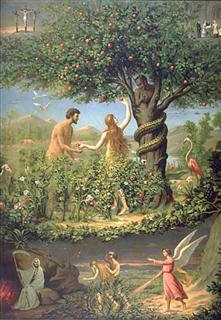
The Church now decided what was right and what was wrong for everyone. What the Church decreed was final, considered a command direct from God himself – you either obey it or are killed as a heathen or pagan.
According to Christian theology, Adam and Eve’s ‘fall from grace’ was not because they eat the apple, but because they had sex and enjoyed it.
Satan, the Serpent, that ‘tempted’ eve, who first showed Eve how to enjoy sex – Eve is said to have than ‘corrupted’ Adam, who also enjoyed sex. Hence Original Sin (Sex) was born.
The Adam and Eve story is known in many cultures. My view is that the Serpent may well have been Ayahuasca or similar plant used by the Shaman.
In Christianity Sex became a great sin, by Church official decree.
Sex was considered a sin even in wedlock.
Babies were now born in sin, because the catholic priests said they were; in a state of perpetual fear, the pubic believed everything the priests said.
We all became sinners just from being born, ‘born in sin’, and hence needed to ‘saved’ from our sinning by the ‘blood of Jesus’ or we would all go ‘straight to helll’.
Jesus was now painted as a man born without sex, never had sex, never looked at a women or had any sexual feelings towards a woman. His mother never had sex, never consumated her marriage, even though she was jewish, and this would have been her primary responsibility as per the old testament.
Catholicism demanded that all sexual intercourse had to be purely mechanical and impersonal while wearing a linen cagool (nightshirt) with the necessary hole. There was only one official sexual position allowed. The Catholic Church laid down severe punishments for deviations from this official position, called the missionary position.
Anything that the Catholic priests decided was a sin became a sin and hence punishable by law.
Bathing and massaging was considered a sin, an overt concern for the sensual.
Sex was only permitted by persons on prmision by the church by a ‘marriage’ by a catholic priest. In wedlock, sex was prohibited on Sundays, Wednesdays and Fridays, amounting to almost half the year. In addition, sex was forbidden during the forty days of Lent, forty days before Christmas and so on. It was also forbidden three days before receiving Communion.
Sex was forbidden with barren women or women during or post menstruation.
Oral sex and anal sex were expressly forbidden by the church, with dire penalties for offenders. Anal sex, often used as a contraceptive method, was a heinous sin. Sodomy is still illegal in some Christian countries.
If a man had an involuntary nocturnal emission, this was also an act of sin; the compensating act of penance for this was to get up and recite three psalms immediately. The next morning he had to recite another thirty psalms. All the family went to the confessional, where details were confessed, nothing could be kept secret.
The Church’s penitential books prescribed the most severe punishments for masturbation, which St. Thomas Aquinas described as a greater sin than visiting a prostitute.
Private or auricular confessions proved to be an excellent weapon for achieving this domination of all sex life by the Church.
Passion and lust were sins and incurred a penalty – as was the sin of loving.
Love was illegal in the catholic church.
The Dark Ages: An Evil Unsurpassed in Human History
People look on Christianity as a force for Good, bringing light and moral guidance to the pagans, a decadent people.
The real history of Christianity though is the direct opposite – a force of evil unsurpassed in human history that plunged civilized Europe into the dark ages.
Christianity ruined peoples lives and set civilization back thousands of years from the glories of Rome and Greece. It was only the determined efforts of brave, enlightened people like Leonardo de Vinci who took on the might of the Catholic Church that led to the European Renaissance and the revival of the Greek Philosophy and Learning.
The idiotic Catholic Church had forced people to live very depressed, wretched and impoverished lives. The Christians seemed to believe that forcing people to live unhappy, miserable lives in total ignorance was a good thing – enjoyment of life, sensual pleasure, happiness and the exploration of nature and its Laws was considered Evil in Christianity.
The ‘Dark Ages’ seriously effected over a billion Europeans for some 1,400 years, and the effects of sexual repression are in force today all over the world because we are all connected via what Yung called the collective unconscious.
Experts put the death toll at about 10,000,000 people including about 2,000,000 women labeled as ‘witches’ then killed or burned to death.
Europeans endured 1,400 years at the hands of religious fanatics.
In the name of God, repressed fanatics searched out people with ‘heretical’ ideas, but in particular those who sinned – this could be anything, but especially sex or anything else that the people enjoyed doing.
In the Christian “Dark Ages” there was neither education, books, nor medicines – people were illiterate and primitive. In contrast, in pagan Rome and Greece even the lowest people could read and write.
With Christianity all previous pagan learning (Egyptian, Greek, Roman, Babylonian) was lost to the general public. Along with this, European massage and massage traditions died as all the bath houses were closed.
Arabic Cultures and Islam
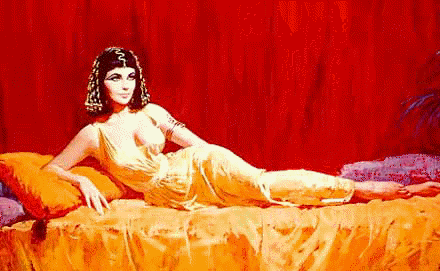
In traditional Arabic culture sensual, erotic dance and the practice of giving sensual massages with aromatic essential oils and luxurious bathing was well established. Arabic belly dancing is still popular today, but the practice is dying in Egypt and elsewhere as sexual repression and fear grips the hearts and minds of men.
Sensuous Massage was particularly well established amongst the Royalty in Egypt where rulers like Cleopatra were well versed in the sensual and erotic arts, including massage and what we would now call Aromatherapy.
Cleopatra’s favorite essential oils included Jasmine and Rose, and she was well acquainted with their sensual effects, and how to use them.
The ancient middle and far eastern cultures rated incense and essential oils very highly – they were sometimes priced higher then Gold.
Egyptians in particular had very precise knowledge of the effects of essential oils and incense, and how to extract the oils with their healing and other properties intact.
There are, for example, nine species of the frankincense tree, each having different properties and their effects were noted and the oils priced accordingly. Other factors like the age, condition of the tree, the season of tapping, the grades of colour and potencies were also reflected in the price and use of the oils.
Other oils of note from the arabic regions included Myrrh and Balsam oil. Traders on caravans traded incense with the far east including Persia and India, and this was by far the most lucrative trade.
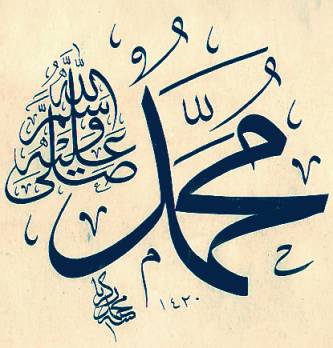
With the birth of Islam, ‘pagan’ Egypt had come under Muslim rule, and hence it’s traditions had a degree of protection from the sexual repression of the Catholics.
The Prophet Muhammad (pbuh) in his early life was a trader, trading in essential oils, incense and other goods such as leather and livestock.
The Prophet was well acquainted with the sensual and other effects of essential oils and how to use them in massage.
The Prophet was opposed to sexual repression, he loved women above all else except God, and required no other luxuries or possessions.
He was considered a great lover of women, who had many wives and concubines.
Islam provided a buffer against the dark ages brought on by the Catholic Church, where people could live in peace and enjoy the simple pleasures in life.
This allowed for cultural and scientific advancement, which led to the golden ages of Islam at the time that Europe was plunged into the dark ages by the Catholic Church.
The European renaissance from the 14th-17th centuries that led by men like Leanardo de Vinci and Michelangelo owes much to the Islamic world. Much of the ‘scientific’ texts that they referred to were preserved or developed in the Islamic world. For example, the Islamic library had Cordoba, Spain had some 400,000 books, including the pioneering works of Avicenna. Avicenna was a follower of Socrates, Plato and Aristotle, and is considered the father of modern medicine, who also invented steam distillation as a way to pure extract essential oils as used in today’s Aromatherapy and Chemistry.
The British Empire and Global Sexual Repression
An unfortunate side effect of the British Empire, where the sun never set, was that repressive Christian sexual morals were transferred to almost all parts of the world, including India, Arabia and the entire Islamic world. Places that previously had been centers for such things as massage and dance.
Around the 16th century three discrete muslim empires existed – the Turkish Ottoman Empire, the Persian Safavid Empire and the Indian Mughal Empire. The British took over from the Moguls in India and immediately set about putting an end to the traditional Indian Tantricas, the Courtesans, the Dancing Girls, Massage and other ‘Pagan’ traditions.
The British generally being devout Christians, viewed such practices as evil or the works of the devil himself!
In fairness, this trend was visible at the time of the latter Mughal Emperors. Aurangzeb and others tried but failed to impose their own brand of repression on the general public, and there are many Sufi verses that speak out against the religious extremism, in particular Kabir and Hazrat Bulleh Shah.
The British though succeeded where others failed and thanks to the British, places like India, Pakistan, Saudi Arabia today are amongst the most repressed societies in the world.
The Whabi House of Saud and Islamic Fundamentalism
The British also imposed the Whabi House of Saud in Saudi Arabia, where they took over from the Ottoman Empire following the exploits of Lawrence of Arabia and the decline of the Turkish Ottoman Empire.
Islam has two traditions – the Sunni and the Shiite. Both have the same fundamental beliefs, but differ in minor, non-religious matters to do with the accession to the Caliphate following the death of the Prophet.
Whabism in contrast has nothing to do with Islam. Whabism is based on the idiotic views of an Abdul Wahab who was born on 1703. This Wahab wanted all Islamic cultural progress over the ages to be reversed. He wanted to take Islamic civilisation back to how he imagined it was in the 5th Century, back to the fundamentals as per his interpretations of the Koran.
No one took Abdul seriously and Whabism had no followers anywhere until the British imposed Whabi rule on the Saudi people, and via them to the rest of the Islamic world.
Islam was based on the well known and well loved example of the Prophet, and grew as a result of societies following the Prophets guidelines. Islam was not based on the Koran, which was not written down at the time of the Prophet and the Prophet expressly refused to have it written down because he was aware of how interpretations of ‘holy’ books are used to mislead the public.
Koranic verses are difficult to understand even by the most learned native arabic speaking persons in the world; a small change in stress changes the meaning of a verse completely. Like poetry, two persons hearing a verse will interpret it differently, depending on such factors as his evolutionary stage.
Following the death of the Prophet, there were wars of accession, where the Prophets grandsons were killed. Many Hadiths attributed to the Prophet were invented or doctored by the rulers of the time for political purposes.
However, because of the Prophets example, Islam flourished and considerable cultural and scientific progress was made leading to the Golden Ages of Islam in Egypt, Iraq, Iran and India. These civilizations were not based on a literal interpretation of the Koran.
These were high civilisations, equivalent to or surpassing those in the West at the time. For example, even as recent the time of the Mughal Empire in India, Islamic India’s Royal Courts were considered equivalent if not superior to the European Royal Courts in terms of the Laws, the Culture, Philosophy and general sophistication of the people.
Islamic Law (Sharia, which means ‘Way’ or ‘Path to the Water Source’) as used in these civilizations was progressive and based on the sayings of the Prophets, the Koran, Analogy, and Centuries of debate. It incorporated non-muslim judicial systems such as Bedouin Law, Meccan Commercial Law, Roman Law and Jewish Law. The development of Islamic Law influenced other later laws including English Law. For example the British Law of Trust is considered to be derived from aspects of Islamic Law called waqf.
Whabism though wanted to turn all this back to the 5th century. They called for a literal interpretation of the Koran, particularly of certain verses only – the ones that could be interpreted as inciting hatred or could be used as excuses to justify female repression or wars against Christians and Jews.
Whaby concept of Sharia is about chopping peoples limbs off that you don’t like or who don’t agree with you.
With the Arab Israeli wars, and the rise in the price of oil in the 70’s there was a huge influx of dollars into the Saudi Kingdom. Much of this money was used for global islamic religious education along Whabi ideas. They managed to indoctrinate societies that were socially well advanced. Grdaually, this led to the imposition of whabism onto the entire islamic world.
Today the entire Islamic world has whabi extremists ruling them – Mullahs, educated in Whabism, like the Taliban decide who does what, what is right and what is wrong. Women are banned from appearing in public places, unless covered in bags from head to toe. All forms of mixed sex dance and massage are banned.
The modern whabi mullahs are much like the Catholic missionaries of old, who believe that it is there purpose in life to impose sexual repressions and other hardships on the public.
There was a recent incidence where a women in Saudi was gang raped by around six men – she was given 90 lashes, which was increased to 200 because she appealed. Such cases are common in all parts of the Islamic world, in some places like Iran sex outside of marriage carries the death sentence.
The Psychological Effects of Sexual Repression
It is well to remember that the Dark Ages in Europe lasted for around 1100-1400 years – a period of severe, inhuman suppression of humanity.
The Catholics were systematic and very thorough, they knew how fear works, and used this fear to effect the minds, beliefs and attitudes of every man, women and child.
The mass public tortures, the mass public killings, the mass public stoning and burnings were designed to have a psychological effect, which would be passed from parent to offspring. It is in force today just below the rational surface. Examine your own attitudes to sex, and you will see it.
From their perspective, the Christians did a damn good job of ruining people.
Though we live in modern times, and the dark ages seem like a myth, the unconscious effects of fear and repression concerned with sexuality still live in us. They are visible just below the surface, they are alive today in our blood, in our inherited DNA and account for much of today’s psychosis, the irrational fear of sex and mental illness that exist just below the surface for so many people.
The Psychological issues associated with this repression are alive today in our own sub-conscious minds, and account for the psychosis and many of the modern attitudes towards the human body and an aversion to any physical pleasures one may have.
An example of this is the public reaction of moral outrage over sexual morality. Some years ago, Americans were so morally outraged when Janet Jackson showed her nipple on TV that there was an avalanche of letters and complaints. At the same time the American army was cluster bombing innocent men, women and children in Afghanistan and then in Iraq. Pictures of this mass slaughter of innocent people was broadcast all over the world on television, but caused no stir at all. Janet Jackson’s nipples though caused mass outrage in the media.
In the modern mindset, the mass slaughter of hundreds of thousands of men, women and children is OK and accepted; the public visibility of a female nipple is not OK and causes the public’s blood to boil in moral outrage and condemnation.
This is typical behavior of psychologically ill people and mentally ill societies.
The Clinical or Robotic Rebirth of Modern Massage
At the end of the nineteenth century in puritanical Victorian England, massage was associated with prostitution. Massage did not exist as a therapy or as something you could study.
In order to combat this, eight women founded The Society of Trained Masseuses in 1884. This later became The Chartered Society of Physiotherapy, and massage was used extensively by Doctors in the two world wars.
This massage was very mechanical, focusing on the manipulation of muscles and joints. Over time mechanical methods began to replace massage, presumably as these new Physiotherapists considered it demeaning to use hands to do a demeaning thing like massage on patients. After all, mechanical aids are more efficient at mechanical manipulation, and self respecting Physiotherapists did not want to be associated with prostitution.
In recent years, particularly with the decline of puritanical Victorian attitudes amongst the general public, massage has again become popular and used by more and more complementary therapists – but in the so called ‘respectable’, clinical or robotic form.
Respectability and Clinical Massage Training
As massage still has Victorian based associations with sex and prostitution, in order to gain respectability modern massage training seems to go overboard in denying any possible connection in the massage to sexuality.
Respectable massage training bodies such as ITEC, FHT, and others do this by making the massage training clinical, above board, professional – like a commercial patient-doctor scenario.
Here the focus is on ‘Professionalism’ – Uniforms, Bureaucracy, the Therapist-Client power relationship (where the Therapist is in charge and orders the client), Contra Indications, Hygiene, Indemnity forms and other such formal matters.
There exist rigid guidelines that come under the label of Preserving Client Modesty, intended to ensure that the therapy can not in any way be considered to have a sexual component of any shape or form. This involves things like rigid Towel Draping regimes and No Massage Zones, where only certain areas of the body are massaged – specifically not any body parts that may be considered erogenous zones, like buttocks, hips, inner thighs (the no massage triangle) and chest for female clients.
Prospects for The Future of Massage
The Future is Bright, the Future is Clinical
It is unfortunate that the western world does not have and strong massage traditions of its own, and has deep feelings of guilt and fear associated with sensuality and sexuality. This is why the standard of massage therapies is so low in the west and so clinical.
Roman style mixed nude baths and daily massages were outlawed by the Catholic Church years ago, and the massage traditions and the expertise has long died.
The general public is not even aware that it has lost something precious. Almost all modern massage training is clinical.
I wish that this could change, and western massage therapies regain their former glories. But this is unlikely because the problem is in the sub-conscious minds of the general public. People are now used to their repressed lives and social structures built around repression.
For many people it’s the only life that they know. They would probably be up in arms, pointing fingers and ‘throwing stones’ should the Elite, the Authorities, Massage Training institutes or Spa’s and Clinics were to offer non-clinical massage because of the possible sensuous contact.
This is not the case in societies that have strong massage traditions. For example, the Thai Royal Family supports traditional Thai Massage and traditional Thai Dance, that goes back to over 2,500 years to Indian Tantra – hence this is respectable and not outlawed. I can’t imagine the British Royal family or anyone else being able to re-establish the respectability of Roman and Greek Massage therapies, mixed saunas and public nude bathing – there is just too much repression underplaying British and Western society.
People here are still living in the Victorian era, and even in the Middle Ages. The Catholic Church, the view that we are all born sinners, and will go straight to hell for having sex and ‘sins of flesh’ still holds sway in the subconscious minds of the vast majority of outwardly sensible people. There is a very deep seated sense of guilt, sin and fear associated with sex, which is unconscious. The issue is seldom, if ever, faced.
As a result the general public is starved of touch and disconnected with their own sensuality. This causes stress and countless associated health, mental and social problems.
However, there are modern forms of massage that have emerged in more affluent societies by more enlightened body workers, such the Esalen form taught by the Esalen institute in California. Unfortunately, such developments tend to get ‘patented’ and operate with a profit motive and have a limited audience.
Buddhist Tantra, Indian Tantra and Tibetan Tantra traditions are more universal, and tantric massages are also slowly growing in the west. As are other forms such as traditional Hawaiian Lomi Lomi massage, Balinese Massage and Traditional Thai Massage. Unfortunately, such massage forms have also denigrated to be fronts for prostitution – money rules!
There is a strong Naturist movement, which has a lot of members and is growing particularly in affluent places such as the South of France. Unfortunately, such hedonistic pursuits tend to be devoid of any spiritual or emotional depth or any offer any true healing.
It is unlikely then that there will be a sea change to the modern clinical, robotic, non-sensual massage – this is because western society and now the entire world seems to gripped by repression and fear. The problem as I said is in the unconscious minds of people, and this will only be cured by internal cleansing, and mind-body detox.
Chances are that we are headed in the opposite direction: more sexual repression, more fear, more psychosis, more wars, more rape, more violence, more stress, more illness, more frustrations, more unhappiness and more misery.
We see more and more religious fundamentalism in Islamic countries, leading to the death of massage, dance and singing. For example, officially there is no massage or dancing in Pakistan, a country carved out of India consisting of areas that in Mughal times were centers for Indian culture, massage therapy, dance and music. The same in Iran, once the cradle of culture in the Islamic and even pre-Islamic world.
Today in the entire Islamic world including Turkey, the mad mullahs and their ‘moral brigade’ has taken control and has imposed all sorts of sexually repressive legislation similar to Catholic Europe of the middle ages.
It is as if European Christian history is repeating itself in the Islamic world.
You hear more and more evangelical rhetoric coming out of the US and the Neo-cons, whose mind set is identical to the muslim fanatics that they are so opposed to.
Even traditional societies like Thailand, India, China and Japan are under a lot of moral pressure from do-gooders in the West to ‘clean up’ – that is to remove or make clinical all forms of massage.
The future of organic, non-clinical massage looks bleak. The future of robotic, clinical massage though is bright.
Our great grand-children will probably look back to the ‘Quaint’ old days when people eat food that they grew, rather then clinically manufactured pills, and massaged each other because they enjoyed it!
Chronological History of Massage
Source: http://www.thebodyworker.com/history.htm
3000 BC- Chinese: Cong-Fu of the Toa-Tse. Oldest known book written about massage. Translated to French in 1700’s.
2760- Nei Ching describes therapeutic touch
2500 BC – Egyptians created reflexology.
2000 BC- First Writings about Massage
1800 BC- Ayurvedic. Art of Life book that included massage techniques. In India, the focus was on sensual massage aspects. Ayur-Veda is a code of life and it deals with rebirth, renunciation, salvation, soul, purpose of life, maintenance of mental health, prevention and treatment of diseases.
1600 B.C.- in Egypt the first record of chemotherapy being employed as a treatment for cancer
1555 BC- A medical papyri contains remedies for all types of illnesses and the methods of application are similar to the ones used in Aromatherapy and Herbal medicine today.
1000 BC- Homer wrote about an oily medium used for massage
776 BC- Olympic Games. Athletes massaged prior to their events.
604-531 BC – The founder of Taoism is believed to be Lao-Tse
500 BC- Herodicus- prescribed gymnastics to heal. Considered to be the founder of medical Gymnastics.
460-380 BC- Hippocrates was taught by Herodicus. Used Friction to treat sprains and dislocations (called anatripsis-Greek for friction). Thought that disease resulted from natural causes and the body has the power to heal itself. Wrote code of ethics that became the Hippocratic Oath. Hippocrates said: hard rubbing binds…much rubbing causes parts to waste…and moderate rubbing makes them grow.
200 BC- Greek physician Galen used natural magnets to relieve pain in treating many illnesses.
200 BC- The Huangdi Nei Jing (Yellow Emperor’s Inner Classic) is the earliest surviving canonical text of traditional Chinese medicine. Anmo is referred to in 30 different chapters of the Nei Jing.
100-44 BC- Romans. Julius Caesar used Massage therapy to relieve his neuralgia and epileptic seizures. Was thought to have been “Pinched” every day.
130 AD- 201 AD – Galen. Originally from Greece. Physician for the school of gladiators who were rubbed before fighting. Wrote book on manual medicine.
90 BC – Chinese created acupuncture.
25 BC- 50 AD- Aulus Cornelius Celsius. Roman Physician. Wrote De Medicina (8 textbooks with a lot of information on massage).
100’s AD – First schools of massage were developed in china
228 AD-337 AD- The Roman Emperor Constantine condemned the baths and gymnasiums as he thought they added to the abuse of sex.
589 AD-617 AD- Sui Dynasty already had knowledge of Massage used as therapy.
600’s – Japanese developed shiatsu (finger pressure or acupressure), anma is massage in Japanese.
980 AD-1037 AD- Avicenna, Persian medic, wrote the Canon of Medicine during the crusades. May have been the first used the process known as distillation to distill essence of rose, although it probably took many years to perfect the process
1300-1368- Guy deChauliac wrote a book on surgery mentioning bodywork as an adjunct to surgery.
1368-1644 In the Ming Dynasty, pediatric massage (which, for the first time, was referred to as “tuina”) evolved into a highly systematic treatment modality which is still popular today.
1517-1590- Ambroise Pare, French barber surgeon, raised awareness of the use of massage
1569- Girolamo Mercuriale wrote the first sports medicine book.
1564-1626- Lord Francis Bacon observed that massage had benefits enhancing circulation.
1608-1679 – Giovanni Alfonso Borelli studied muscular contraction.
1660-1742 – Prussia. Friedrich Hoffman, physician to King of Prussia recommended rubbing and gymnastics for the royal court.
1742-1823 – John Grosvenor, English surgeon practiced healing with hands.
1776-1839 – Per Henrik Ling- fencing master and gymnast studied massage after he cured himself of rheumatism in his arm. Developed a system of Medical Gymnastics. Per Henrik ling is not the father of swedish massage!!
1800’s-Reiki is believed to date back to early Tibetan healing practices. Discovered in the 1800’s by a Japanese philosopher and Christian seminary educator, Dr. Mikao Usui
1813- Per Henrik Ling formed the Royal Gymnastic Central Institute in Stockholm, Sweden. His students carried on his work after his death.
1828-1917- American osteopathic medicine was begun by Andrew Taylor Still. For more information see www.meridianinstitute.com in their early manual medicine collection.
1837 – Ling’s disciple, M. LeRon brought Movement Cure to Russia, St. Petersburg.
1839-1909 – Johann Mezger. Holland. Brought medical massage to scientific community. Started using the terms effleurage, petrissage and tapotement.
1850s- scientific massage therapy was introduced in the United States by two New York physicians, brothers George and Charles Taylor, who had studied in Sweden.
1856 – Mathias Roth, English physician, taught Charles Fayette Taylor and George Henry Taylor who brought massage to the US
1852-1943 – John Harvey Kellogg, Battle Creek Sanitarium used massage and hydrotherapy. Published magazine called “Good Health”
1850s- Karl von Reichenbach discovered kerosene and paraffin
1879 – Douglas Graham-described lomi lomi and wrote a history of massage. May have been first to use massage in USA.
1880 – Mary Putnam Jacobi and Victoria A White in New York City. Medical Doctors and professors who researched the benefits of massage and ice packs in the management of anemia.
1884 – Professor Charcot. French Physician taught Sigmund Freud. Though French doctors should use massage more.
1884 – Massage Scandals in Europe. Physicians became skeptical of claims made by massage therapist and accused practitioners of stealing patients.
1894 – Society of Trained Masseuses formed in Britain. Set up study of massage along with prerequisites for education and criteria for school recognition.
1895 – Sigmund Freud. Used Massage Therapy to treat hysteria. Studies in Hysteria. Postulated that what we did not or will not confront in our lives would be buried in the body in the unconscious mind.
1895 -Harvey Kellogg -“The Art of Massage”
1899 – Sir William Bennet- Started a massage department at St. George’s Hospital in London.
1800’s-Canadian Deep Muscle This technique addresses specific muscles and muscle groups. The practitioners are trained to fix specific problems. It is a fundamental technique that offers fast results for both pain and stress. This form of cross fiber massage was first written about in the late 1800’s in New York City.
1900 – Albert Hoffa- wrote book “Technike der Massage”.
1900s early- Jin shin jyutsu, the “art of circulation awakening,” was developed in Japan by Jiro Murai and brought to the United States in the 1960s by Mary Iino Burmeister.
1900’s early- The Alexander Technique was developed by an Australian actor F.M. Alexander
1907 – Edgar Ferdinand Cyriax- Used Ling’s Swedish Movement Cure and Mechanotherapeutics.
1907-Naprapathy originated by a chiropractor in
Chicago. This also concerns connective tissue.
1913 – Dr. William Fitzgerald rediscovered Reflexology and called it Zone Therapy.
1917- James Mennell. London. St. Thomas Hospital. Did physical treatment by movement, manipulation and massage.
W.W.I- Swedish massage used for rehabilitation of injured soldiers.
1927 – New York State Society of Medical Massage Therapists (first massage association)
1929 – Elizabeth Dicke, German physical therapist created “Bindgewebs massage” or connective tissue massage. Used reflex zones.
1930’s – Hospitals staffed Physical Therapists who were doing massage.
1930- Neuromuscular Therapy created by Stanley Leif. For a more detailed history of Neuromuscular Therapy see Judith Walker Delaney’s website
1932 – Emil Voder. Danish physiologist created Manual Lymph Drainage.
1934 – Wilhelm Reich – Austrian psychoanalysis. Freud’s student. Used Somato techniques to dissolve muscular armor. Attempted to cure neuroses by releasing their corresponding muscle tensions by using breath, movement and physical manipulation. The community was outraged at the thought of using physical contact. He was sent to prison for his conflicts and died there. Bioenergetics created by Alexander Lowen, emerged from Reich’s work.
Also wrote “Joy – The surrender of the body to life”, Depression and the Body: The Biological Basis of Faith and Reality “Depression has become so common that one psychiatrist even describes it as a “perfectly normal” reaction.
1937-A French chemist, Rene Maurice Gattefosse, began his research into the healing powers of essential oils after burning his hand in his laboratory and immersing in it in lavender oil and being impressed by how quickly the burn healed. He published a book about the anti -microbial effects of the oils and coined the word Aromatherapy.
1939 – The Florida State Massage Therapy Association Inc. (FSMTA) was first organized on June 15, 1939 one of the oldest massage organization, with 85 charter members. The first Massage Act was passed by the Florida Legislature in 1943.
1940 – James Cyriax, son of Edgar Ferdinand Cyriax, and British Osteopath, created deep transverse friction.
1943 – Chicago American Association of Masseurs and Masseuses formed. Later to become American Massage Therapy Association. Dues were $.50.
1949 – Massage Registration Act formulated by AMM.
1944 – Harold Storms- Storms technique for fibrositic nodules.
1950’s – Francis Tappan and Gertrude Beard wrote books and articles on massage techniques.
1952 – Janet Travell researches Triggerpoints.
1952-Hoshino Therapy developed by Tomezo Hoshino, Hoshino Therapy is an official medical therapy in Argentina.
1956 – Margaret Knott and Dorothy Vass wrote a book called “Proprioceptive Neuromuscular Facilitation”.
1960’s – Albert Baumgartner used Massage in Athletics.
1960’s – Esalen became a center to explore human potential. Ida Rolf did her first trainings there. Deane Juhan worked there. Bernie Gunther trained people to do massage.
1964 – Applied Kinesiology was founded by Chiropractor George Goodheart
1966 – Raymond Nimmo-Wrote book ” The Receptor Tonus Method “, which came from his work with “noxious generative points”.
1960’s late- John Barnes,developed Myofascial Release Therapy
1971-Core Energetics Started by Dr. John Pierralcos in 1971, core energetics adds a more spiritual aspect to bioenergetics.
Core Energetics: Developing the Capacity to Love and Heal
by John C Pierrakos
1972 – Moshe Feldenkrais, writes “Awareness Through Movement” which follows up to his 1949 publication The Body and Mature Behavior.
The Potent Self: A Study of Spontaneity and Compulsion by Moshe Feldenkrais, Michaeleen Kimmey . Studies of sensory awareness and movement re-education somewhat based on F.M. Alexander’s work.
1973-Zero Balancing was developed by osteopath and acupuncturist Dr. Fritz Smith
1976-Myotherapy (book) developed by Bonnie Prudden
1977- Aston-Patterning is developed by Judith Aston (form of rolfing)
1978- Joseph Heller started Hellerwork (form of rolfing) www.hellerwork.com www.www.josephheller.com
1978-Soma Neuromuscular Integration developed by Bill Williams, Ph.D, one of the first students of Ida Rolf
1980’s – Association of Bodywork and Massage Practitioners formed.
1980s-Watsu (water therapy) was developed by Harold Dull
1980’s-Taws Method (Soft Tissue Release) was developed by Stuart Taws (his website), a British sports rehabilitation therapist now residing in America
1981 – Lauren Berry, a physical therapist and mechanical engineer, recorded his methods of manipulating joints, “The Berry Method, Volume I”
1981- Lawrence H. Jones identifies tenderpoints and develops “Strain- Counterstrain” techniques of treating points.